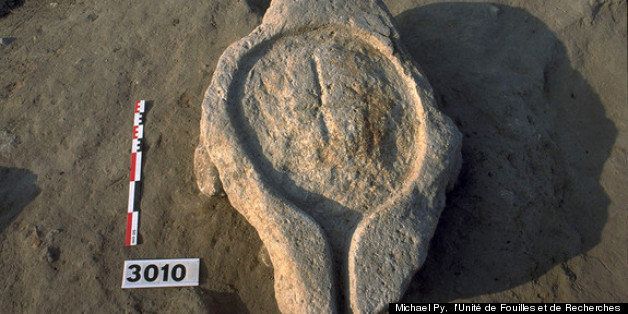
By Helen Fields
Winemaking is as French as baguettes and mimes. But how did the drink come to the region in the first place? A new study confirms what archaeologists had long figured: Though the ancient Romans brought their own wine to France, the country was making and importing it long before they arrived.
In 525 B.C.E., the people of Lattara, on the Mediterranean coast near Montpellier in present-day France, were France's native Celts. They spoke a language related to Welsh and Gaelic and enjoyed a fermented drink—maybe beer or mead. A building in their walled town housed Etruscan merchants, people from a pre-Roman civilization around Tuscany. Conveniently for the archaeologists who have been excavating the site since the early 1980s, that building collapsed in 475 B.C.E, burying the merchants' goods under the broken walls and roof. Many of their amphoras were crushed in place. These ceramic vessels were used to transport and store all kinds of goods, including dried fruit and olive oil—and wine.
Archaeologists thought that these amphoras were probably used to transport wine, partly because they appeared to have pitch on the inside, which dissolves in olive oil. Anthropological archaeologist Benjamin Luley, then a Ph.D. student at the University of Chicago in Illinois, was interested in understanding how the lives of Celtic people changed after the Roman Conquest. He was working on the site as the amphoras were excavated and took samples from the ones with visible residue at the bottom. After 2500 or so years in the ground, the bases weren't super clean. "We actually kept the dirt because we wanted to analyze the dirt, too, as a sort of control," Luley says.
He and his colleagues also took an unusual step for their pottery-centric field: sampling from a coffee table-sized limestone press, of a type that could have been for olives or grapes, from 50 years or so after the building's destruction. It's on display at a museum near the site. Luley and another researcher took a stone chisel and carefully scraped a roughly 5-centimeter square area off the artifact, a few millimeters deep. "We did it when there were no visitors," he says, but, surrounded by displays, he was aware that people would be looking at the stone later. "We didn't want to put a big scar on it."
The samples were sent to the United States for chemical analysis. Researchers led by biomolecular archaeologist Patrick McGovern at the University of Pennsylvania analyzed the samples for compounds including tartaric acid, a chemical that is found in grapes and some other fruits and is often used to show that wine was present. The methods included liquid chromatography-mass spectrometry, done on state-of-the-art equipment at the Bureau of Alcohol, Tobacco, Firearms and Explosives laboratory in Beltsville, Maryland, that is normally used for analyzing drugs.
The researchers found tartaric acid, suggesting wine, and other chemicals that suggested that pine resin was present in the amphoras—it could have been a preservative or flavoring, like in modern day retsina, or used to waterproof the vessels. They also found some evidence that herbs such as thyme and rosemary may have been included in the Italian-made wine. That wine was imported, but, as the team reports online today in the Proceedings of the National Academy of Sciences, it also found tartaric acid in the scrapings from the press. That suggests that the press was used to squash grapes—and that Celts were already producing their own wine around 400 B.C.E., more than 2 centuries before the Roman conquest.
Moving away from pots to look at the limestone press was "a rather neat innovation," says Carl Heron, an archaeological scientist at the University of Bradford in the United Kingdom. Chemical analysis of old samples is always tricky, he says; the samples have spent thousands of years in the environment, with all sorts of possible contamination, including plants and bacteria. The methods that used to be used to analyze them, such as infrared spectroscopy, aren't always reliable. This paper uses more advanced, sensitive methods—a good direction for the field, he says.
Archaeologists already thought those amphoras were for wine, because the evidence from this and other sites suggests that's the only Etruscan product these Celts were interested in, says archaeologist Michael Dietler of the University of Chicago. He's Luley's Ph.D. adviser and works at the Lattara site, but wasn't involved in this study. At the sites where the Etruscan amphoras were emptied, he says, "we find lots and lots of drinking cups." Also, the remains of grape seeds and stems have been found nearby, while olive pits were rare—and, just outside of the settlement, archaeologists have even excavated a 3rd century B.C.E vineyard. "It was already pretty clear that there was wine production going on there, but this just adds a nice bit of confirmation," Dietler says.
ScienceNOW, the daily online news service of the journal Science.
